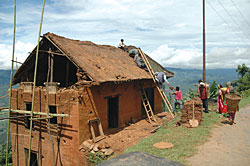 KIRAN PANDAY |
Caste relations are being transformed as urbanisation gathers pace in the Palpa village of? Hungi, a village on the banks of the Kali Gandaki which is a microcosm of the country.
Hungi is remote, but it is no backwater. Proximity to a river ensures that farmland is fertile and well-irrigated, so most people have enough to eat. A few even have televisions.
"Nobody is starving here, there are only a couple of households struggling. There's more than enough food to go around," asserts Baikuntha Pant, a young returnee.
For generations, this relative prosperity sustained a division of labour between the Brahmins, who occupied the fertile lowlands, and the Magars, who lived high up in the adjoining hills. A few Brahmin households owned most of the land and commissioned the Magars to work the fields for a share of the harvest.
But much has changed with people leaving for the cities. The key landowning Brahmin families have sold their property piecemeal to finance investments in the city. Many of the buyers are Magars.
"Before, all my parents' neighbours were Bahuns, but the demographics have definitely changed now," says Janak Raj Pandey, who works and lives in Kathmandu.
With city jobs and farmland of their own, the Magars now have more lucrative alternatives to working on Brahmin-held land.?This has closed income disparities between ethnic communities, and given rise to a new, more diverse village elite. Inevitably, some people have come to resent these changes.?
"Look, there's the new rich," scowls my companion, gesturing to a richly adorned Magar woman during a walk through the village.
For the most part, however, these changes have been received peaceably. The bigger danger to social harmony comes from a different angle. While income disparities between communities have narrowed, those within them have widened. Many Magars buy property in the lowlands with remittances from relatives working abroad. Those less fortunate continue to toil high up in the hills.?
?"Life is still tough for me. I have two children and sometimes I struggle to feed them. Before I would get some help from my neighbours, but most have left for the lowlands," says Sujata (name changed), whose husband works odd jobs in Kathmandu.
Among Brahmins, too,?income gaps have widened between families with children doing well in the cities, and those that rely solely on farm income. The impact of these changing sources of income has been keenly felt in the local school. As the value of education, in preparing students for city jobs, has grown, enrolment figures have soared.
Urbanisation has benefited those communities with the means to take advantage of it, leaving the marginalised out in the cold. Hungi's experience is mirrored by the Nepali Living Standard Survey, which shows that while the income poverty rate has dropped, income disparities between communities have widened across the country.
Anthropologist Mukta Singh Tamang explains, "The poverty rate among the mostly high-caste groups who live in or near urban centres and are educated has declined more rapidly than the poverty rate among communities in rural centres." Tamang attributes this in part to rising remittances and low agricultural productivity.?
With the 2011 census expected to reflect these changes, it's time the government figured out how to make urbanisation work for everyone.


